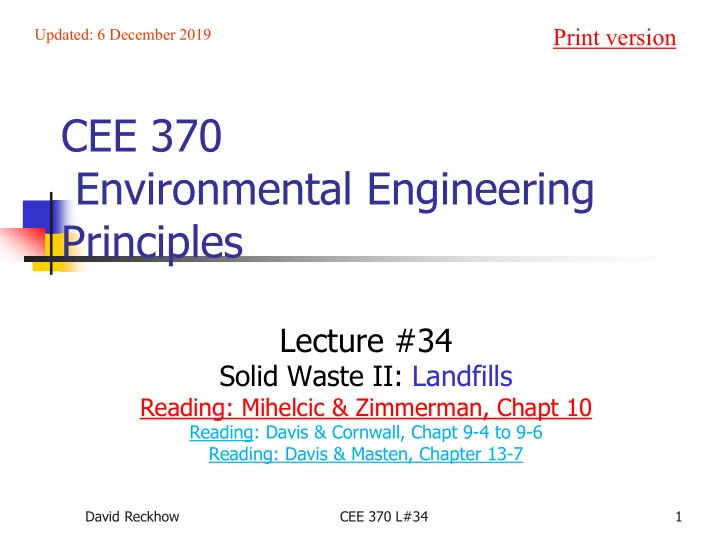

Print version Updated: 6 December 2019 CEE 370 Environmental Engineering Principles Lecture #34 Solid Waste II: Landfills Reading: Mihelcic & Zimmerman, Chapt 10 Reading: Davis & Cornwall, Chapt 9-4 to 9-6 Reading: Davis & Masten, Chapter 13-7 David Reckhow CEE 370 L#34 1
Landfilling The legal and controlled placement of wastes in the ground Dumping is illegal or uncontrolled Material undergoes chemical and biological changes Water is present which promotes biodegradation and carries away dissolved substances: Leachate Leachate collection and recirculation 2 CEE 370 L#34 David Reckhow
Leachate Characteristics Constituent Conc. Range, mg/L BOD 5 9-55,000 COD 0-90,000 Total solids 6-45,000 TDS 0-42,000 TSS 6-2,700 Chloride 34-2,800 TKN 0-1,400 Sulfate 1-1,800 Phosphate 0-154 Lead 0-5 Copper 0-10 pH 3.7-8.5 3 CEE 370 L#34 David Reckhow
Leachate Recycle leachate recirculation in municipal solid waste landfills as an effective way to enhance microbial decomposition of biodegradable solid waste. With leachate recirculation, a landfill can be used as a relatively controlled anaerobic filter to treat leachate provide accelerated waste stabilization, and reduce the volume of leachate by maximizing evaporative losses during recirculation Leachate should be introduced slowly, In order to maximize waste since high flow rates may deplete buffering capacity and remove stabilization, leachate recirculation methanogens, increasing the flow rates frequency must be carefully selected. and frequency of recirculation as gas If too much leachate is recirculated, production is established. Waste problems such as saturation, ponding, decomposition can be improved by an and acidic conditions may occur. increase in the moisture flow, as a result of increased flushing and dilution of the inhibitory products. 4 CEE 370 L#34 David Reckhow
Leachate Treatment A typical leachate treatment plant uses equalization, oxidation/reduction, precipitation/flocculation/sedimentation, neutralization, granular media filtration 5 CEE 370 L#34 David Reckhow
Siting Restrictions The landfill disposal regulations provide the following restrictions on landfill location: • Prohibit the placement of a landfill facility near an airport because of dangers from scavenging birds. • Require the landfill to be located outside the 100 year floodplain or the landfill design must prevent the washout of solid waste during a 100 year flood. • Prohibit the placement of a new landfill or expansion of an existing landfill into or on a wetland. • Prohibit the placement of a landfill within 200 feet of an earthquake fault. • Prohibit the placement of a landfill in an area with a high probability of a strong earthquake. • Prohibit the placement of a landfill in an area with unstable soil. • Require existing landfills which cannot meet the airport, floodplain, or unstable area requirements above, to close within five years. The state may grant a maximum of a two year extension. 6 CEE 370 L#34 David Reckhow
Operational Requirements Exclusion of hazardous waste from the landfill. Provide at least six inches of daily soil cover over new solid waste placed in the landfill. Control disease vectors such as rodents and insects. Monitor methane concentrations in the landfill and buildings. (Methane is explosive when combined with the oxygen in air.) Elimination of most open burning. Control public access. Construct run-on and run-off controls for water. Meet water quality discharge requirements (NPDES) to surface water. Prohibit all liquid wastes except small quantities of household liquid wastes. Maintain records indicating compliance. 7 CEE 370 L#34 David Reckhow
Design Requirements Synthetic membrane liner at least 30 mils thick 1 mil is 0.001 inches Soil liner at least 2 ft. thick Hydraulic conductivity no more than 10 -7 cm/s Other state-approved designs possible 8 CEE 370 L#34 David Reckhow
Solid Waste Disposal Sources Disposal Regulations Recycling Composting Collection Processing Landfilling Incineration 9 CEE 370 L#34 David Reckhow
Landfilling: Area Method SW placed on surface, compacted 10 CEE 370 L#34 David Reckhow F Si & Si 1996
Trench Method Trench is excavated, SW placed in, and compacted From Sincero & Sincero, 1996 11 CEE 370 L#34 David Reckhow
12 CEE 370 L#34 David Reckhow
Leachate Composition 13 CEE 370 L#34 David Reckhow
Landfill Gas Not pure methane 14 CEE 370 L#34 David Reckhow
15 CEE 370 L#34 David Reckhow
From Davis & Cornwell, 1991 16 CEE 370 L#34 David Reckhow
Landfill siting 17 CEE 370 L#34 David Reckhow
18 CEE 370 L#34 David Reckhow
19 CEE 370 L#34 David Reckhow
To next lecture 20 CEE 370 L#34 David Reckhow
Recommend
More recommend